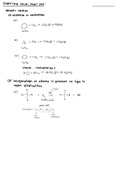Sn1 reactions Study guides, Class notes & Summaries
Looking for the best study guides, study notes and summaries about Sn1 reactions? On this page you'll find 97 study documents about Sn1 reactions.
Page 4 out of 97 results
Sort by
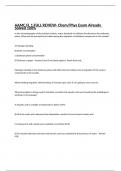
-
AAMC FL 1 FULL REVIEW- Chem/Phys Exam Already Solved 100%
- Exam (elaborations) • 25 pages • 2023
-
- $15.99
- + learn more
In the chromatography of the reaction mixture, water absorbed on cellulose functioned as the stationary phase. What was the principal factor determining the migration of individual components in the sample? A.Hydrogen bonding B.Solute concentration C.Stationary phase concentration D.Thickness of paper - Answer B and D are dumb options. Knock them out. hydrogen bonding to the stationary phase will determine the relative rate of migration of the various components in the sample. When...

-
AAMC FL 1 FULL REVIEW- Chem/Phys correctly answered 2023
- Exam (elaborations) • 24 pages • 2023
- Available in package deal
-
- $19.99
- + learn more
AAMC FL 1 FULL REVIEW- Chem/Phys correctly answered 2023In the chromatography of the reaction mixture, water absorbed on cellulose functioned as the stationary phase. What was the principal factor determining the migration of individual components in the sample? A.Hydrogen bonding B.Solute concentration C.Stationary phase concentration D.Thickness of paper - correct answer B and D are dumb options. Knock them out. hydrogen bonding to the stationary phase will determine the relative rat...
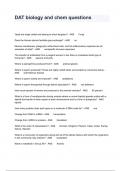
-
DAT biology and chem questions And Answers
- Exam (elaborations) • 3 pages • 2024
-
- $13.39
- + learn more
DAT biology and chem questions Yeast are single celled and belong to which kingdom? - ANS Fungi Does the Human dermis facilitate gas exchange? - ANS no Mucous membranes, phagocytic white blood cells, and teh inflammatory response are all examples of what? - ANS nonspecific immune responses The transfer of antibodies from a pregant women to her fetus is considered what type of immunity? - ANS passive immunity Where is epinephrine produced from? - ANS ...
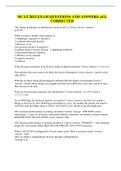
-
MCAT 2022 EXAM QUESTIONS AND ANSWERS ALL CORRECTED
- Exam (elaborations) • 34 pages • 2022
-
Available in package deal
-
- $13.99
- + learn more
The change in enthalpy in endothermic reactions (H) is Correct Answer: positive g=H-TS When you take a breath, what happens to: 1) diaphragm (expands or contracts) 2) external intercostal muscles 3) thoracic cavity 4) is pressure positive or negative? 5) surface tension Correct Answer: 1) diaphragm contracts 2) intercostal muscles contracts 3) thoracic cavity expands 4) negative pressure 5) reduced What electronic transition of an H atom results in photon emission? Correct Ans...
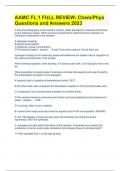
-
AAMC FL 1 FULL REVIEW- Chem/Phys Questions and Answers 2023
- Exam (elaborations) • 17 pages • 2023
-
Available in package deal
-
- $22.49
- + learn more
AAMC FL 1 FULL REVIEW- Chem/Phys Questions and Answers 2023 In the chromatography of the reaction mixture, water absorbed on cellulose functioned as the stationary phase. What was the principal factor determining the migration of individual components in the sample? A.Hydrogen bonding B.Solute concentration C.Stationary phase concentration D.Thickness of paper B and D are dumb options. Knock them out. hydrogen bonding to the stationary phase will determine the relative rate of migrati...
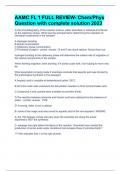
-
AAMC FL 1 FULL REVIEW- Chem/Phys Question with complete solution 2023
- Exam (elaborations) • 17 pages • 2023
-
Available in package deal
-
- $15.49
- + learn more
AAMC FL 1 FULL REVIEW- Chem/Phys Question with complete solution 2023In the chromatography of the reaction mixture, water absorbed on cellulose functioned as the stationary phase. What was the principal factor determining the migration of individual components in the sample? A.Hydrogen bonding B.Solute concentration C.Stationary phase concentration D.Thickness of paper B and D are dumb options. Knock them out. hydrogen bonding to the stationary phase will determine the relative rate of...
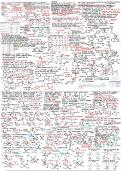
-
UBC CHEM 233 Final Cheat Sheet
- Summary • 1 pages • 2023
-
- $8.99
- + learn more
- UBC CHEM 233 cheat sheet used on the 2022W1 final exam - Comprehensive, includes fischer and newman projections, ARIO, Sn1 and Sn2 reactions, oxidation state, hydrogenation, nucleophilic acyl substitution, carbohydrate cyclization, hydrolysis of enamine, imines and acetals/ketals
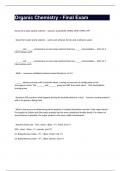
-
Organic Chemistry - Final Exam
- Exam (elaborations) • 7 pages • 2023
-
- $8.49
- + learn more
Organic Chemistry - Final Exam Name the 6 polar aprotic solvents - acetone, acetonitrile, DMSO, DMF, HMPA, THF Name the 5 polar protic solvents - acetic acid, ethanol, formic acid, methanol, water ______ and ______ mechanisms are two step reactions that have _____ intermediates. - SN1; E1; 2 Intermediates each ______ and ______ mechanisms are one step reactions that have _____ intermediates. - SN2; E2; 1 Intermediate each Allylic - resonance stabilized (carbon bonde...
These are class notes for CHEM 108, the second exam, in Dr. Mirafzal's class.
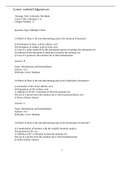
-
Package Title: Solomons Test Bank Course Title: Solomons 11e Chapter Number: 15
- Exam (elaborations) • 119 pages • 2022
-
- $10.89
- + learn more
Package Title: Solomons Test Bank Course Title: Solomons 11e Chapter Number: 15 Question Type: Multiple Choice 1) Which of these is the rate-determining step in the nitration of benzene? a) Protonation of nitric acid by sulfuric acid b) Protonation of sulfuric acid by nitric acid c) Loss of a water molecule by the protonated species to produce the nitronium ion d) Addition of the nitronium to benzene to produce the arenium ion e) Loss of a proton by the arenium ion to form nitrobenzene Answer: D...

Do you wonder why so many students wear nice clothes, have money to spare and enjoy tons of free time? Well, they sell on Stuvia! Imagine your study notes being downloaded a dozen times for $15 each. Every. Single. Day. Discover all about earning on Stuvia



